Is Cashmere a Natural Fiber? Exploring Its Natural Origins and Uses
Is Cashmere a Natural Fiber? Exploring Its Natural Origins and Uses
Blog Article
Discover the Appeal of Cashmere an All-natural Fiber: Why It's a Must-Have in Your Wardrobe
The allure of cashmere, a luxury all-natural fiber, transcends plain looks. Originating from the Kashmir region, this light-weight yet resilient product has woven its method right into high-end style as a result of its distinct homes and flexible charm. From reviewing its fascinating beginning to comprehending its production care, process, and top quality, it's worth checking out why cashmere holds such a special location worldwide of textiles. Discover the class and compound of this fiber as we get started on an expedition of its allure.

The Beginning and Background of Cashmere: A Brief Review
While lots of may check out cashmere as an easy deluxe, its background is steeped in abundant cultural tradition. Originating from the Kashmir area in India, cashmere wool has actually been produced for thousands of years. The fiber is obtained from the soft undercoat of cashmere goats, gathered throughout their molting season.
Understanding the One-of-a-kind Properties of Cashmere Fiber
Cashmere, renowned for its distinctive qualities, sticks out on the planet of fabrics. This extravagant fiber is incredibly soft, giving a comfy and comfortable feeling unlike any various other. It is considerably warmer than wool, making it an excellent option for winter season garments. In spite of its warmth, cashmere is surprisingly light-weight and doesn't add unneeded bulk. This all-natural fiber is additionally recognized for its sturdiness. While other products might wear down in time, cashmere keeps its high quality, guaranteeing durable wear. Cashmere possesses an unique visual allure. Its gentle radiance and style make it a staple in high-end style. Understanding these properties makes clear why cashmere is not simply a high-end, however a beneficial financial investment for any type of closet.

The Refine of Producing Cashmere: From Goat to Garment
To value the luxurious buildings of cashmere fully, one need to understand its journey from the raw fiber to the ended up item. The process starts with the cashmere goats, predominantly discovered in Mongolia, China, and Iran. The soft undercoat of these goats, collected throughout their natural molting season in spring, gives the raw material. This fragile fiber is then meticulously separated from the coarser outer hair in a labor-intensive procedure known as dehairing. The pure cashmere is then dyed, these details spun into thread, and ultimately weaved or woven into the sought after garments. Each action is diligently performed to protect cashmere's significant heat, soft qualities, and sturdiness. This complex process causes the production of an absolutely extravagant material.

Translating the Quality and Cost: Why Is Cashmere so Expensive?
Cashmere stems from the great undercoat of the cashmere goat, with each goat creating a simple 150 grams yearly. The processing of raw cashmere requires both time and competence, with the fibers requiring to be very carefully sorted, washed, and rotated. These variables integrated make cashmere a pricy yet extremely popular asset in the globe of fashion.
Cashmere in Fashion: The Versatility and Classic Allure
Regardless of its high price, the ageless allure and flexibility of cashmere have actually strengthened its place in the realm of style. The functional nature of cashmere allows for its combination right into both formal and informal attire, indicating its broad charm. As patterns come and go, cashmere continues to be a constant, its appeal undiminished, proceeding to motivate and form the fashion industry's landscape.
Taking Care Of Your Cashmere: Maintenance and Preservation Tips
Making certain the longevity of cashmere garments needs specific treatment and focus. These treasured possessions ought to not be tossed right into the cleaning equipment with normal washing. Rather, hand cleaning with mild, pH-neutral soap in warm water is recommended. After washing, they must not be wrung out. Instead, they must be carefully pushed between towels to take in excess water, then laid flat to dry. Routine brushing with a cashmere comb can stop pilling. Keeping these items in a great, completely dry location, preferably in a breathable bag, can secure them from moths and humidity (is cashmere a natural fiber). An occasional airing outside, away from direct sunlight, can refresh the fibers. With these upkeep and conservation suggestions, one he has a good point can ensure their cashmere remains resilient and luxuriously soft.
Final Thought
Cashmere, with its unequaled softness and warmth, supplies both high-end and durability. Discover the allure of cashmere and boost your fashion repertoire.

Report this page